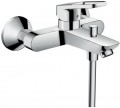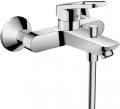Water jet angle
The angle of the water jet produced by the tap, relative to the vertical. Generally stated for full head; with partially blocked water, this angle is smaller. Anyway, the water jet is usually directed towards the user, and the greater the angle of inclination, the farther from the spout the point of incidence of the jet will be placed. However, in most cases this point is not critical; problems can arise only in very cramped conditions, with small basin sizes.
Features
The functions of a mixer mainly consist of design features, among which are the presence of a
check valve, a
pop-up waste,
cold start,
LED lighting, a
temperature control lever, a
display,
auto-drain (hygienic rinse), a
switch for washing machine/dishwasher, and a
shelf for accessories. More details:
— Check valve. A check valve prevents water from moving backward through the mixer, for example, when there is a significant pressure difference between hot and cold water. This feature is relevant for those planning to install water meters: the presence of check valves on mixers is often a mandatory condition for installation requests, as such valves prevent meters from running backward. Additionally, it's worth noting the presence of a check valve in the mixer (especially single-lever ones, see "Mixer Type") if your home's water supply is prone to interruptions — such mixers perform much better during pressure surges in the plumbing.
— Pop-up waste. A device that allows you to close the drain hole in a sink, kitchen sink, or bidet (depending on the purpose of the mixer). It comes in two types:
— Lever pop-up waste. This type of valve is operated by a small
...lever located behind the mixer, to the side, or at the front of the body. Raising and lowering it opens and closes the sink's drain plug.
— Push-button pop-up waste. Valves of this type are locked and unlocked by pressing the drain hole plug, which requires wetting your hand.
— Cold start. A feature found exclusively in single-lever models. The general principle of "cold start" is as follows: if you open the mixer with the joystick in the central (default) position, only cold water will flow out, not mixed warm water (as in more traditional single-lever devices). To add hot water and increase the temperature, you need to move the lever from the default position. This operation format can provide noticeable savings: by default, cold water flows from the mixer, and hot water is added only as needed.
— LED lighting. A lighting system based on LEDs — an efficient and economical light source. The purpose and functionality of such lighting can vary. In some models, it is installed on the spout and directed downward, allowing you to see the space under the mixer well even in low external lighting. Sometimes this lighting also illuminates the water stream, giving it an unusual appearance. There are also quite original systems — for example, with a transparent spout and LEDs at its base, creating the effect of a mixer glowing from within; in some models, the lighting even changes color depending on the water temperature. However, in any case, this feature significantly affects the cost, so it is mainly characteristic of premium-class products.
— Auto-drain (hygienic rinse). This system is equipped in mixers with additional electronics — mainly contactless models, as well as products with a thermostat or button activation. Auto-drain works as follows: at certain intervals (for example, once every 12 hours or once a day), the automation briefly turns on the water. This washes out harmful bacteria that tend to multiply on the internal surfaces of the spout and in the "stagnant" water inside the mixer. At the same time, the water consumption for hygienic rinsing is small, usually almost unnoticeable against the background of overall consumption.
— Temperature control lever. A feature found in mixers whose design initially does not include a temperature regulator — primarily contactless models, as well as products with one main lever or button activation (see "Mixer Type"). As the name suggests, the temperature control lever allows you to use such a mixer not only for controlling the flow but also for changing the water temperature.
— Display. Mixers that display the temperature and/or current water consumption. The display provides a clear visualization of settings and allows you to see what water and in what volume is flowing from the tap. However, the presence of a screen significantly affects the cost of the mixer.
— Switch for washing machine/dishwasher. A feature that can significantly simplify the connection of a washing machine or dishwasher to the water supply system. Mixers with a switch for a washing machine/dishwasher have a separate pipe for connecting the machine, as well as a switch that allows you to open and close the water supply to this pipe. Thus, to connect a washing machine or dishwasher, there is no need to install additional bushings, splitters, etc. — just connect the device to the existing outlet. And you can control the water supply directly from the mixer body, without having to crawl under the sink or into another hard-to-reach place.
— Shelf for accessories. Most often, the role of such a shelf is played by the upper part of the body, specially made flat. This feature is mainly found in mixers for baths and/or showers (see "Purpose"): it is convenient to keep shampoos, gels, soap, and other cosmetic/hygienic products on the shelf.
Note that this feature is rare — mainly in high-end mixers (in particular, thermostatic ones) that initially have large body sizes. In more traditional models, there is no point in providing this design element — it is more reasonable to purchase a shelf as a separate accessory for the bathroom.Water flow
The maximum water flow during the operation of the tap, in other words, the maximum amount of water that it can pass through in a minute. This characteristic is important, foremost, for models designed for baths (see "Suitable for"): the greater the throughput, the faster the bath will fill. However, the meaning of this paragraph is not limited to this. First, flow information can be useful in certain calculations related to water supply — for example, to calculate the required pump capacity. Secondly, high-end taps can be equipped with aerators to achieve a powerful and efficient jet with low water consumption; the consumption indicated in the characteristics allows you to evaluate the efficiency of such devices in comparison with analogues.
Diverter
A diverter is a device that switches a water flow between spout and shower head. The design of such a device and the way it is controlled can be different, in modern taps you can mainly find the following options:
— Button. Diverters of this type have the form of a button; but its design depends on the characteristics of a particular tap. In relatively simple mechanical models (most of them), the button is also made mechanical, and to switch from spout to shower, you need to pull it up. And switching in the opposite direction — from a shower to a spout — can often be carried out not only manually, but also automatically, when the water is turned off (see "Features — Shower / bath auto switch"). In some taps, auto-switching can also be blocked by the user (usually by turning the button in the up position).
In turn, in advanced electronic devices, such a diverter is made in the form of an electric button that closes the contacts that control the valve.
— Lever. Diverter in the form of a rotary lever. Most often, this lever directly controls the valve that switches the flow of water. This design is considered somewhat less reliable than push-button, but it is much simpler and cheaper, which makes it very popular — especially in relatively inexpensive taps. But in premium devices, this type of diverter can operate according to other, more advanced principles — for example, a lever can work as an electronic switch.
— Turning the spout. A r...ather rare and specific option: the role of the lever that controls the flow of water is performed directly by the spout, to the base of which a shower hose is connected. Such a control, usually, works as follows: while the spout is perpendicular to the tap body, water flows through it, and to switch to the shower, the spout turns, being under the tap. Such devices look interesting, and are convenient to use. On the other hand, they are quite complex and expensive, and the spout itself, for a number of reasons, is typically made quite short. Therefore, this variant has not gained popularity.
— Removable. A diverter located outside the body — usually between the tap itself and the spout. Typically, on one side of such a device there is a control element (most often a small lever or a rotary tap), and on the other, a pipe for connecting a shower hose. And the name "removable" suggests that this part can be easily removed if needed — unlike, for example, push-button or lever solutions, which are usually built directly into the tap body and are very difficult to dismantle or replace. Accordingly, after removal, the diverter can either be replaced with another one, or removed altogether by connecting the spout directly to the tap. This is the main advantage of this option: in case of malfunctions in the diverter, it can be removed without any problems for repair or replacement, while the tap (with the exception of the “shower part”) remains fully operational.

